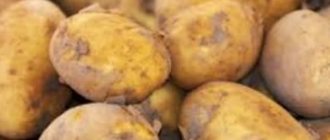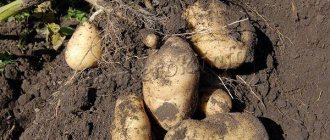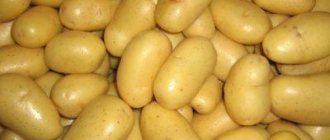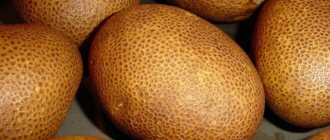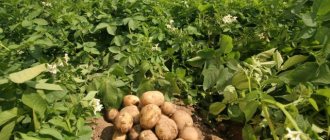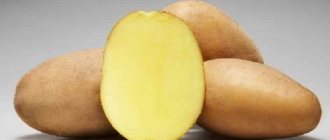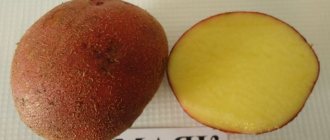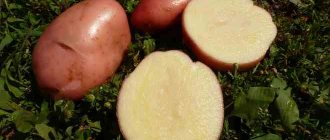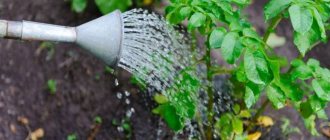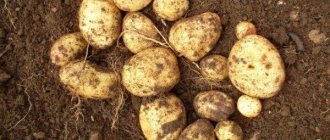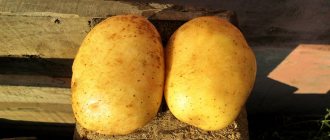Kamensky potatoes: description, characteristics, yield, reviews, photos
Kamensky is an early ripening variety.
Ripening occurs 50-60 days after planting the material. The tubers have a red, rough shell. There are small small eyes located on the surface. The shape of the root crops is oval, oblong. The color of the pulp is dull yellow, sometimes yellow. Does not change its color when damaged or heat treated.
Due to the high starch content (approximately 16-18%), root vegetables quickly crumble during heat treatment.
The average weight of a mature root crop is 110-130 g. There are also specimens weighing up to 180 g.
1. Precocity. As noted earlier, the variety ripens 2 months after planting.
2. High yield. From 1 hectare of planting you can harvest 50-55 tons (500-550 quintals) of high-quality potatoes. It is also worth noting that this is a fairly high indicator, given the early ripening of the variety.
3. Drought resistance. Kamensky can tolerate short-term droughts without pain.
4. Taste qualities. Kamensky has good taste. On a 5-point scale he is given 4.8.
5. Resistant to mechanical damage. Potatoes are not afraid of long-term transportation and are suitable for mechanical harvesting.
6. Versatility. Tubers are suitable for making purees and salads. Kamensky also feels great fried and in soups.
7. Keeping quality. Tubers of this variety are stored very well. The shelf life percentage, under favorable conditions, reaches 97%.
The bush itself is tall and of intermediate type. Stems are semi-erect, less often erect. The plant is covered with medium-sized leaves of a dark green color. The leaves have pronounced wavy edges.
The inflorescence includes a large number of fairly large flowers of a red-violet hue.
The root system of the bush is very developed. One plant can form up to 25 medium-sized root crops.
Characteristics of the variety include history of origin, external description of the bush and root crop, and yield.
The Kamensky variety was developed by Russian breeders. Refers to early species. Scientists from the Ural Scientific Research Institute of Agriculture worked on it. In 2009, potatoes were included in the Russian state register. It is intended for cultivation in the Ural and West Siberian regions.
The bush is tall, semi-erect. The leaves are light green in color with characteristic wavy edges. Blooms with red and purple flowers. The stems are dense. The vegetative period lasts 50 – 60 days.
The root crop is medium in size, the average weight is 70 - 150 g, there are tubers of 180 g each. They are covered with a thin red peel, forming shallow eyes. The pulp is white, contains 18% starch, and softens when cooked. According to tasters, the taste is good.
The productivity of Kamensky is high; 500 - 550 centners of potatoes are harvested from one hectare. One bush produces up to 25 tubers.
The Kamensky variety has its advantages and disadvantages. The advantages include:
- High yield.
- Early ripening of fruits.
- Duration of storage and transportability of the crop.
- Unpretentious care.
- Resistance to the Colorado potato beetle and some diseases.
Among the disadvantages, there is a tendency to become infected with the golden nematode.
Currently, breeders have more than 4,000 varieties of potatoes. Each of them is unique in some way, has its own positive and negative sides.
Gardeners, when choosing a variety for cultivation, first of all pay attention to taste, resistance to diseases, pests and unpretentiousness to the soil. An important factor is also rapid maturation.
Among these 4,000 varieties, only seven are almost not affected by the Colorado potato beetle. One of these is the Kamensky potato, bred by breeders in the Urals. It also has many other advantages that please farmers.
Root crops have an oval-elongated shape with an average weight of 100-130 grams. The maximum recorded tuber weight is 180 grams. The pulp inside is light yellow, the peel is red, has a rough texture and a retina. The eyes of root vegetables are small, superficial, and relatively close to each other. The variety is also distinguished by its high starch content - 16.5-19% and good taste.
The stems of the plant are erect and dark green in color. The leaves on the shoots are medium to large in size with a wavy edge. Compared to other potato varieties, they are very tough. The color is dark green. The inflorescence is quite large, with an anthocyanin color on the inside.
The variety was developed recently, but it can be assumed that thanks to its unique characteristics it will soon take root in every agricultural plot. The main ones are:
- High yield. From 10 to 15 tubers grow under one bush, and more than 50 tons of potatoes can be harvested from one hectare of planting land. None of the popular foreign varieties had such results. It is also pleasantly pleasing that such indicators are stable and the yield does not depend on the year.
- Precocity. This variety can be harvested already on the 60th day after planting.
- Unpretentiousness to soils. Kamensky adapts perfectly to any type of soil.
- Drought resistance. The plant tolerates drought well, and its earlier ripening allows for a high harvest even in the driest year.
- Taste qualities. The variety belongs to the elite. It received a rating of 4.8 on a five-point taste rating scale.
The main advantage of the Kamensky variety is its resistance to the worst enemy of potatoes - the Colorado potato beetle. The parasite cannot bite through hard leaves and powerful shoots, which cannot but please farmers and amateur gardeners.
Another advantage of potatoes is that they have a double skin. If the top layer of the root crop is damaged during collection or transportation, another dense, red peel remains underneath it.
The plant is also resistant to many diseases:
- rhizoctonia;
- cancer;
- late blight of tubers;
- common scab.
This feature allows it to be grown in one place for many years.
Unfortunately, nothing is absolutely ideal and the Kamensky potato variety also cannot consist of only advantages. It also has one drawback - vulnerability to potato nematode.
Pink potatoes attract not only buyers at the market, but also experienced agronomists. “Kamensky” is one of the famous elite potato varieties, which is very popular among gardeners. Domestic breeders developed root crops.
“Kamensky” is a potato variety that tolerates drought well, is unpretentious in care, and is resistant to the Colorado potato beetle, which is very rare for nightshade vegetable crops. According to the state register, it is recommended to grow it in the Urals and the Volga-Vyatka region. Weather conditions do not affect the formation of the crop, which is a significant factor for many farmlands.
The bushes grow 50-70 cm, the tops are thick, the leaves are small, painted dark green. Young tubers can be harvested already on the 45-50th day, after the seed root crops have sprouted. Excellent for growing for sale.
The potatoes are formed into an oval shape with a slight elongation. The surface of the tubers is rough. Peel color is pink with a red tint. The average weight of a potato is 100-130 grams. The pulp is crispy due to its high starch content - 16-18%.
Regardless of the year and conditions, the yield is consistently high - 45-55 tons per hectare of plantings.
“Kamensky” is a table variety; you can prepare various first and second courses from it. Shows resistance to late blight, mosaic, cancer, and viral diseases. Potatoes are practically not subject to mechanical damage, thanks to the double peel. It lies well in the winter, but wakes up early due to its early ripeness.
Potatoes "Kamenskoye" may become your favorite variety. Which advantages will attract your attention, and which disadvantages will upset you a little?
Positive properties of Kamensky potatoes:
- the yield indicator depends little on climatic conditions and soil;
- taste qualities were rated 4.8 points;
- the plant is not attacked by the Colorado potato beetle;
- tolerates scorching sun and shaded areas;
- the thick peel allows it to be transported over long distances without much damage;
- keeps well in winter.
The disadvantage of the Kamensky potato is its susceptibility to potato nematode. To protect the plant, it is necessary to monitor crop rotation and also add urea, which makes the soil acidic, which is an unfavorable environment for the nematode.
Why doesn't the Colorado potato beetle eat the leaves of this variety? It's all about the hard leaves of the plant, which the pest does not like. Breeders achieved this effect by modifying the variety.
Due to its popularity, potatoes are a staple food crop in many countries around the world. This was facilitated by the good adaptability of potatoes to any growing conditions: cold climate, poor soil, temperature fluctuations.
European breeders have long been leaders in developing varieties with high yields for the northern regions. Russian researchers also devote a lot of time to studying features and identifying patterns.
Therefore, in each individual region of Russia, breeders are working, developing new varieties that will show high yields and immunity against diseases in a particular region.
History of creation
The Kamensky potato was bred by Ural breeders and included in the Register in 2009. Scientists from the Ural Scientific Research Institute of Agriculture were able to endow this variety with the qualities of the best elite specimens: high yield, resistance to major pests and infections, excellent taste and unpretentiousness.
Description
The Kamensky potato variety was bred specifically for regions with a temperate climate, especially for the Ural, West Siberian and Volga-Vyatka regions.
At the same time, its unpretentiousness and endurance make it possible to obtain high yields in any conditions; in Moscow and the region, and even more so in the southern regions with their fertile soils and warm climate, gardeners receive record yields.
Potatoes Kamensky
Description
The Kamensky potato variety was bred specifically for regions with a temperate climate, especially for the Ural, West Siberian and Volga-Vyatka regions. At the same time, its unpretentiousness and endurance make it possible to obtain high yields in any conditions; in Moscow and the region, and even more so in the southern regions with their fertile soils and warm climate, gardeners receive record yields.
Potatoes Kamensky
Kamensky belongs to the early ripening potato varieties; the first tubers can be dug up 1.5 months after planting and young potatoes can be eaten. The green part of the plant is very lush, with a thick trunk and elastic, bright leaves. The tubers are round and slightly elongated in shape. The peculiarity of the variety is its double thick peel of bright pink color, thanks to this property the potatoes can be stored for a very long time. Inside the fruit is pale yellow and dense. High starchy content allows potatoes to be used for frying and boiling; they do not fall apart. In general, this variety belongs to the table variety, which allows you to cook it in any way.
Kabardian horse breed: history, description, photo
Characteristics of Kamensky potatoes
| Parameter | Meaning |
| Productivity, c/ha | Maximum 550 |
| Maturing period, months | 2 |
| On 1 branch fruits grow, pieces | Maximum 25 |
| Weight of 1 tuber, kg | 0.13 |
| Starch content, % | 18 |
| Bush height, m | 0.7 |
| Safety in winter, % | 97 |
Advantages and disadvantages of the variety
- The positive qualities are as follows:
- precocity;
- drought resistance;
- frost resistance;
- productivity;
- high taste qualities;
- resistance to the Colorado potato beetle;
- transportability.
- The variety has practically no negative characteristics. This can only include
- low shelf life inherent in table varieties, and susceptibility to attack by nematodes.
The main advantages include:
- High yield. Each bush produces 10-15 tubers;
- Precocity. Harvesting is possible 60 days after planting;
- Unpretentious to soils. This variety has excellent adaptation to any type of soil;
- Drought resistance. Potatoes tolerate dry periods well;
- Taste qualities. It is an elite variety;
REFERENCE: On a five-point scale of taste, the score is 4.8.
- The main advantage is that it is resistant to the Colorado potato beetle.
The only drawback of the Kamensky variety is that it is susceptible to potato nematodes.
The variety has been cultivated for a long time in Russia and in neighboring countries, and summer residents have already been able to highlight its main advantages and disadvantages. Among the advantages it is worth noting:
- Productivity does not depend greatly on climatic conditions.
- Kamensky has excellent taste.
- The variety is not picky about soil type.
- Kamensky is less likely than other varieties to be attacked by the Colorado potato beetle.
- Does well in dry conditions.
- Thanks to the thick shell, root crops are not damaged during transportation and during mechanical harvesting.
- Has high keeping quality.
There is only one significant drawback: Kamensky is not protected from potato nematode, which infects it more often than other varieties.
Positive properties and features that the Kamensky potato variety has:
- Rapid ripening of the crop within two months.
- The potato belongs to elite varieties, and its taste was rated at 4.8 points on a five-point scale.
- The type of soil and weather conditions do not have a strong influence on yield indicators.
- Stores well in winter.
- Due to the thick peel, the tubers safely withstand long-term transportation without noticeable damage.
- It is not afraid of the scorching sun or shaded areas.
One of the disadvantages of this variety is the ability of tubers to germinate already at a temperature of 3 °C.
Reviews from gardeners
Svetlana
An excellent new variety, I was not at all disappointed that I chose it for planting. The tubers sprouted very quickly, and the tops came up within a week of being planted. There were no Colorado potato beetles over the summer; the first potatoes were dug up in mid-July. I really liked the taste. By autumn, the entire harvest had already been dug up. The fruits successfully stored all winter, did not deteriorate and retained their taste. Next year we plan to increase the number of plantings.
Vitaly
I grow Kamensky for myself and for sale. The variety gives good yield, and the tubers look attractive; they are bought on the market faster than anyone else. I plant potatoes using the trench method, it’s faster, I hill up only once during the whole season, when planting I added a handful of ash, and didn’t use any other fertilizers. I really like the variety; it is the most successful of all domestic new products.
Description of the variety. Starch content
Roots:
- The peel is red, rough, and has a pronounced mesh surface;
- Medium ocelli, superficially located;
- The flesh varies from pale yellow to yellow when cut;
- Tubers are oval, oval-elongated;
- The cut flesh does not darken;
- Contains a high level of starch - from 16.5 to 18.9%;
- Average weight from 110 to 130 grams.
Escapes:
- The bush is stem-shaped, erect, intermediate type, dark green in color;
- Dark green leaves of medium to large size, rather rigid, with pronounced wavy edges;
- The corolla is large in size, with a pronounced anthocyanin color inside.
Description
The bush of this variety is erect, of medium height with hard, small, dark green leaves. The edges of the leaves are wavy. Kamensky potatoes are early ripening varieties; the first harvest can be harvested 45 days after emergence. The tubers are medium-sized, elongated, oval in shape. The eyes are small and lie close to the surface. The peel is double, red with pronounced roughness.
The color of the pulp is light yellow. The starch content of tubers is high, approximately 16.5 to 18.9%. The average weight of potatoes is 110-130 g, the weight of the largest specimens is 180 g. The yield of Kamensky potatoes is stable and high, approximately 50-55 tons per hectare.
Correct fit
Basic landing rules:
- Planting of potatoes of the Kamensky variety begins in early May;
- The tubers are planted in soil heated to 7-9 degrees;
- The depth of planting material is about 6-10 centimeters. The depth of the holes depends on the type of soil. For light sandy soil, the tubers need to be deepened to 12 centimeters, and for clay soil - up to 5;
REFERENCE: The tubers have a double peel: having damaged the top layer, the pulp remains unharmed, since it is protected by a denser red peel.
- A handful of wood ash or onion peels is added to the holes as an additional source of nutrition for young plants, as well as to repel wireworms;
- When planting, the distance between the bushes should be at least 30-35 centimeters, the row spacing should be at least 60-70 centimeters. This will allow the plant to receive enough light, as well as enough soil to bury the potatoes later.
They begin to plant planting material when the soil has warmed up to 8-10 C to a depth of at least 10 cm. In the Southern regions, planting begins in early May, in the Central part of the country closer to the 20th of the same month, but in the North closer by the beginning of summer.
Also, our grandmothers very often found their way around the birch tree. If buds have begun to bloom on this tree, then the soil is ready to “receive” planting material.
Only healthy tubers are allowed for planting. There should be no growths, stains, cuts, cracks, etc. on their surface. Also, it is ideal if medium potatoes weighing at least 60, but not more than 80 g are selected.
Planting is carried out according to the standard pattern: 35x70 cm. The large distance between the rows ensures good natural aeration and illumination of the bushes.
If the soil is poor in organic matter, then during planting you can additionally fertilize each hole. It is recommended to use wood ash as fertilizer. If it is not there, humus will be an excellent alternative.
The variety is not afraid of drought, but this does not mean that it does not need to be watered. On the contrary, timely watering will help to obtain maximum yield. Kamensky is watered only three times per season:
- After the tops appear.
- Before flowering.
- Immediately after flowering.
It is also worth noting that experienced gardeners do not recommend watering Kamensky after flowering has ended. The thing is that during this period the late blight fungus is activated, for which moisture is an ideal environment for spread.
Also, do not forget about hilling. It allows you to increase productivity by 20-30%. This is achieved thanks to the additional stolons that are formed during hilling. Also, during hilling, the soil is loosened and weeds that have a depressing effect on the crop are removed.
Growing Potatoes
To get a good potato harvest, you need to choose fertile soil on the site. Soil characteristics - light loamy or sandy loam soils are suitable for planting.
Instructions for use of the product Commander against the Colorado potato beetle and harm to humansRead
Preparing the soil for planting
Prepare the soil for planting in the fall. Before plowing the area, cow dung or compost is added to it. After removing weeds and fertilizing, the field is plowed and left to rest until spring. In the spring, before planting, the soil is plowed again and furrows are cut for planting potatoes.
This variety gives a good harvest when planted in an area where legumes, annual grasses and flax previously grew. You can plant potatoes together with beans; such proximity will not negatively affect the harvest, but, on the contrary, will improve it.
Preparing the achene
To obtain an early harvest, some gardeners germinate the achenes of the tubers before planting them. This will speed up the process of tops emerging and young tubers setting.
Sprout potatoes before planting in a damp room. This result can be achieved by simply placing the potatoes in a warm but dark room.
There is another way of germination: the tubers are placed in wooden boxes in a damp room, the layers are sprinkled with a mixture of soil and sawdust, you can use hay or grass. Sprinkle the boxes with water and cover with film until germination. Then the film is removed and growth continues until planting in the ground.
Landing
Planting of the Colette potato variety as described is carried out depending on the weather conditions of the region from mid to late May - early June. The air should warm up to 24 degrees, the ground to 15 degrees. Plant potatoes in loose and slightly moist soil. There are three ways to plant potatoes:
- smooth;
- trench;
- ridge
The planting method depends on the characteristics of the site - the level of groundwater and the humidity of the region. If there is constant water on the site, then you need to plant the tubers using the ridge method, and if the site is plagued by constant droughts, then choose the trench or smooth method. The distance between the seeds is chosen depending on the size. So, a small achene is planted at a distance of 30 by 70 centimeters, the planting depth is 10 centimeters. After planting, it is necessary to take care of the plants to obtain a rich harvest.
Potatoes "Kamensky": description of the variety and cultivation
Therefore, breeders are trying to create more and more successful and productive varieties of this plant. Today, there are over 4 thousand different varieties of potatoes, each of which has its own advantages and disadvantages.
And among this diversity, the domestic variety “Kamensky” is popular.
Compatriots managed to appreciate all the features of this root crop; let’s take a closer look at its description and cultivation technique.
Potatoes "Kamensky" belong to the elite varieties. The potato got its name thanks to the region where it was bred – the Urals. Scientists there have created a vegetable that is ideal for ripening in the regions of Western Siberia, the Urals and the Volga.
However, this does not mean at all that the root crop will not take root in other conditions. On the contrary, if he managed to adapt to the harsh climate, then he is not afraid of anything. Potatoes can withstand even dry periods. This variety is an early ripening variety.
The tubers fully ripen within 2 months after planting.
The size of the stems of seedlings ranges from 50 to 70 centimeters. The bushes are covered with many dark green leaves of medium size, the tops of the potatoes are quite thick. The shape of the tuber itself is large and elongated.
Advice
The surface is reticulate, rough, with an abundance of small eyes. The main distinguishing characteristic of the domestic variety is that the tubers are double and colored in a beautiful red-pink color.
The weight of one potato is about 130 grams. On average, you can collect about 15-25 root vegetables from one bush. This means that a whole hectare will yield approximately 50 tons of ripe tubers. At the same time, the yield of this variety is very stable from year to year.
Tubers contain quite a lot of starch - about 18 percent. Due to this, the potato pulp is crispy and dense. The taste makes this variety slightly different from yellow potatoes - it is creamier. But “Kamenskaya” is in no way inferior to it. Tubers are perfect for boiling and frying, deep-frying, as well as for preparing various dishes: mashed potatoes, stews, casseroles, and so on.
But the characteristics of domestic potatoes also make them an excellent candidate for growing for sale.
The dense peel does not allow the tubers to be damaged during transportation, and the beautiful pink color makes the tubers stand out from the rest, judging by the reviews of gardeners.
And also a big advantage of “Kamenskoye” potatoes is the ability to maintain integrity during long-term storage up to 97%! Not every variety can boast of such numbers.
But if you collect seed root crops yourself, then you need to select them immediately after harvesting the last harvest, and not plant any tubers left over from the winter. During the initial sorting, it is necessary to analyze which bush produced the most potatoes.
It is these root crops that should be left as seed material for the next season.
After storage, the tubers also need to be carefully examined for rot, parasites, damage, and so on. Do not plant damaged or cut potatoes under any circumstances; you will not get a good harvest. In addition, there will be a risk of infection of the next generation of vegetables.
note
When you have already sorted through all the tubers, you can proceed to sprouting them. After all, planting potatoes without sprouts in the ground is simply pointless. By spring, many root crops will germinate on their own. But if for some reason this does not happen, you can speed up the process of roots appearing.
There are several options for this, and the most common ones are dry and wet. The first method involves storing a box of sorted tubers in direct sunlight. This will provoke an acceleration of metabolic processes in the tuber, its skin will turn green, and its eyes will sprout.
Such tubers will no longer be suitable for food, but they are excellent for planting.
The wet method is done like this: place the potatoes in 1-2 layers in a warm room (10... 20 degrees). Keep them like this for about 2-3 weeks, spraying them with water from time to time to speed up the germination process.
There is a second option for wet germination, even simpler and faster. Place the seed potatoes in a box and cover it with wet sawdust or humus.
Place the box in a warm place and wait for the tubers to germinate.
The procedure for preparing the soil is no different from the others: the ground must be carefully dug up, loosened, and harrowed. And also completely get rid of any weeds on the site. Do not neglect this procedure, because this will help you further protect the tubers from parasites and various diseases.
“Kamenska” potatoes are completely unpretentious in care; they are not even afraid of drought. However, to obtain a truly rich harvest, it is still better to loosen the soil from time to time and water the seedlings during flowering. But it is also necessary to completely destroy all weeds in a timely manner.
Only then will all the moisture and nutrients from the ground go to the tubers, and not to the weeds. You also need to hill up the potatoes when the bush grows 10 cm, and then when it rises to 30 cm above the ground.
All these procedures are completely simple; they must be performed for absolutely every potato variety.
Feeding the bushes is not a mandatory procedure, but it will undoubtedly improve the quality and quantity of the harvest. Therefore, whenever possible, fertilize the soil with manure diluted with water, bird droppings or any other mineral substances.
Important
Since the Ural potato has a rather dense double skin, the Colorado potato beetle and wireworm are simply powerless against it. But insects also cannot bite through strong and strong shoots of the plant. The tubers of the variety are resistant to common diseases of the nightshade family: scab, fusarium, late blight, and so on.
You can dig up Ural variety potatoes either manually or by machine. This can be done already on the 60th day after planting. Experts recommend digging up potatoes in warm weather at an air temperature of about 20 degrees.
The harvested crop should be spread on some kind of covering and left in the fresh air to allow the tubers to dry. Then you need to immediately sort through the potatoes so as not to leave damaged roots.
It is also important to thoroughly clean all dirt from the fruit.
Sorted root vegetables must be stored in a cool, dry place with good ventilation. Any basement or cellar in which the air temperature is no more than 3 degrees is perfect. And also in the basement you need to make 2 compartments: for seed and table potatoes.
This variety is perfect for growing for sale and for private farming. Gardeners highlight the particular advantage of this variety of root crops as its absolute resistance to the Colorado potato beetle, the main enemy of potatoes.
In general, most reviews about the variety are positive.
For an overview of the Kamensky potatoes, see the following video.
To grow the Kamensky variety, select a site with suitable lighting, humidity and soil composition.
Kaminsky potatoes are suitable for growing in northern regions. Thanks to its early ripening, it manages to produce a good harvest that is not affected by unfavorable weather conditions.
Potatoes prefer good and constant light. The optimal air temperature for growth is 20 – 24 °C. Regular watering ensures additional formation of tubers and absorption of minerals. However, frequent flooding of the soil contributes to fruit rotting, so it is recommended to install drainage.
The Kamensky variety is not picky about the choice of soil. It survives on any soil. A favorable composition for it is a mixture of peat, humus and sand. On loose and airy soils, the yield is higher than on heavy and wet soils.
Characteristics:
- Resistant to mechanical damage;
- Application. It belongs to the elite varieties of table potatoes, suitable for storage. This variety has good shelf life - 97%, subject to the temperature regime not exceeding 3ºC. Otherwise, the tubers will begin to awaken;
- Commercial appearance of tubers - from 85 to 94%.
The first step is to select potatoes for planting or purchase tubers or seeds. If we are talking about the first option, then the tubers are put aside during harvesting. In this case, you can immediately see whether the bush is affected by the disease, what is the level and quality of its yield. Having selected good specimens of medium size, without damage or rot, they are put in a shady place.
2–3 weeks before planting, the potatoes are transferred to a room with a temperature of 10–20 °C and laid in one or two layers to further prevent breakage of the sprouts. While the tubers are sprouting, they must be sprayed with a sufficient amount of water. In the first half of May, you need to choose a place well lit by the sun, fertilize the soil and plant sprouted potatoes 10–15 cm deep at a distance of 30 cm between the bushes and 60 between the rows.
As mentioned earlier, the Kamensky potato variety is unpretentious in care and resistant during periods of drought. To achieve good yields, it is sufficient to timely loosen the soil, remove weeds as they appear and abundant watering during the potato flowering period. But the hilling procedure will not be superfluous:
- the first time it is carried out when the stems have just appeared and the length of the sprouts has reached 5–10 cm;
- the second time this is done when the bushes reach a height of 30 cm.
Features of care
Caring for Evolution potato plantings will not cause much trouble for the farmer. The plant does not need to create specific growing conditions. But to get a generous harvest, you need to monitor the condition of the soil around the bushes and, if necessary, water the plants. Let's look at the basic rules for caring for the Evolution variety in more detail.
Did you know? The Indians who lived in the territory of modern Peru were the first to grow potatoes. More than 4,000 years ago they began cultivating this plant and developed more than a hundred of its varieties.
Fertilizer
If organic and mineral fertilizers were added to the soil during the preparation of the site for potatoes and during planting, then the plants are not fertilized again. Excess fertilizer (especially nitrogen) in the soil can significantly reduce the yield, since all the plant’s energy will be spent only on the growth of tops. You can additionally scatter wood ash between the rows of bushes to prevent the appearance of the Colorado potato beetle.
Weed removal
The key to successful potato growing is proper care of the soil around the plants. As a result of this, the bush quickly grows green mass, and after flowering it forms beautiful and large tubers.
A list of soil care actions in potato beds is presented below:
- weeding is especially important during the period from the appearance of the first shoots to the beginning of flowering. Weeds must be removed regularly, as they absorb moisture and nutrients from the soil, shade young potato sprouts, thereby preventing their growth;
- loosening the soil - it is recommended to carry out it after rain or watering to improve the air permeability of the soil;
- Hilling up plants - helps to form a nest of tubers and has a beneficial effect on the condition of the root system of plants, prevents the growth of weeds and drying out of the soil. The stems are hilled for the first time after they reach a height of 20 cm, and after 2–3 weeks this procedure is repeated;
- Mulching potato beds helps keep the soil moist and loose and prevents the appearance of weeds.
Important! Tubers of the Evolution variety have a high tendency to germinate, so they need to be stored in a dark place
Watering
In regions with a temperate climate, potato bushes only need the amount of moisture they receive during the rains. Additional watering is recommended only during a long period of drought, which is accompanied by high air temperatures.
The rules for watering potatoes are listed below:
- The bushes can be watered for the first time only 20 days after the appearance of young shoots.
- The bushes can be watered a second time, if necessary, before flowering begins, so that the inflorescences do not fall off due to lack of moisture in the soil.
- During periods of severe drought, potatoes can be watered again at the peak flowering stage.
- The last time the plants can be watered is immediately after flowering.
- Drip irrigation systems can be used to water the bushes.
Important! You cannot water the plants after flowering has ended and active tuber formation has begun - this can provoke late blight.
Pest and disease control
Evolution potatoes have good immunity and practically do not suffer from scab and late blight of tubers. In addition, plants are rarely attacked by potato nematode. But sometimes bushes can suffer from an invasion of the Colorado potato beetle or suffer from leaf blight.
Let's consider methods of dealing with these problems and possible preventive measures:
- Late blight of tops. The cause of a fungal infection is waterlogging of the soil in combination with cool weather. Dark spots appear on the leaves of the bushes, which over time acquire a brown tint or become covered with a white coating. To save the crop, the beds are sprayed with a solution of copper sulfate or Bordeaux mixture. To prevent the disease, you need to carry out preventive treatment of seed material before planting and follow the recommendations for proper planting and watering of plants.
- Colorado beetle. The insect lays eggs on the leaves of the plant, from which pink larvae hatch. They eat the green mass of the plant until the tubers ripen, which leads to loss of yield. Potato bushes should be periodically inspected and if a small number of beetles or larvae appear, pests should be collected manually. If there are too many larvae, the beds are sprayed with special insect repellent chemicals.
General information about potatoes
The vegetable crop was bred at the Agricultural Research Institute in the Urals. Scientists managed to develop one of the resistant varieties in the Russian Federation in a very short time. After several years of testing, in 2009 it was included in the state register of breeding achievements of Russia.
It is recommended to grow the crop in the West Siberian region, as well as in the Urals. The vegetable belongs to varietal varieties, so after harvesting it can be planted the next year, no quality characteristics change.
The above-ground part is inedible and is intended for photosynthesis. Bush-shaped plant. The stems grow erect, thick, and pigmentation can be seen over the entire surface. With strong growth, the bushes begin to lie on the ground.
The leaf blades are medium in size and painted a rich green color. The surface of the leaves is hard with strong veining. The leaf blades are wavy at the edges. The inflorescences are large, a large number of flowers are formed. The formed corolla is distinguished by a red-violet hue.
Root crops of the Kamensky variety are formed in an oval-elongated shape. On average, the mass of a tuber reaches 100-130 grams. The peel is painted a rich pink color, with tints of red. The surface of the potato is rough. The eyes are yellow, small, and located on the surface. 15-25 fruits are formed under the bush. The size of the tubers is uniform, peas are not observed.
The pulp is dense, juicy, and light yellow in color. The starch content is in the range of 16-19%. Boils quickly. The taste is excellent. After heat treatment it does not darken. Officially, the ripening period is set at 50-60 days, but gardeners note that potatoes are ready for consumption already 40-45 days after planting.
Necessary conditions for cultivation
To grow the Kamensky variety, select a site with suitable lighting, humidity and soil composition.
Region of growth
Kaminsky potatoes are suitable for growing in northern regions. Thanks to its early ripening, it manages to produce a good harvest that is not affected by unfavorable weather conditions.
In temperate and southern regions, it allows you to harvest a double harvest per season. In the south, potatoes ripen faster.
Illumination, temperature, humidity
Potatoes prefer good and constant light. The optimal air temperature for growth is 20 – 24 °C. Regular watering ensures additional formation of tubers and absorption of minerals. However, frequent flooding of the soil contributes to fruit rotting, so it is recommended to install drainage.
Optimal soil composition
The Kamensky variety is not picky about the choice of soil. It survives on any soil. A favorable composition for it is a mixture of peat, humus and sand. On loose and airy soils, the yield is higher than on heavy and wet soils.
Pests and diseases
What was not mentioned in the list of advantages of the variety was its main distinguishing feature - absolute resistance to attacks by the Colorado potato beetle. This is explained by the fact that the insect is simply unable to bite through the powerful shoots and hard leaves of the plant.
The main weakness of the variety is considered to be its vulnerability to the golden potato nematode. But here too there is a way to avoid crop loss. It will be enough to fertilize the soil with urea, which makes the soil acidic and unsuitable for the development of nematodes, and also do not forget about the crop rotation of the site.
The indisputable advantage of the Kamensky variety is its perfect resistance to the Colorado potato beetle.
It is resistant to diseases such as:
- Potato cancer;
- Late blight of tops and tubers;
- Various mosaics;
- Viral infections;
- Alternaria blight;
- Fusarium;
REFERENCE: If agricultural practices and crop rotation are followed, susceptibility to nematodes does not lead to diseases and does not in any way affect the quality properties of potatoes and their yield.
- Verticillium;
- Common scab.
The only negative is that it is susceptible to potato nematode.
Diseases and pests
The most important difference from other potato varieties is that Kamensky has absolute resistance to the Colorado potato beetle!
In addition, there is resistance to diseases such as potato canker, late blight of tops and tubers, various mosaics and viral infections, Alternaria, Fusarium, Verticillium, and common scab.
The only disadvantage of this potato is its susceptibility to potato nematode.
By following agricultural practices and crop rotation, susceptibility to nematodes does not lead to diseases and does not affect the quality of potatoes and their yield.
Caring for Kamensky includes loosening the soil, minor irrigation, mulching and fertilizing. Read more about when and how to apply fertilizers, and how to do it correctly when planting.
Kamensky is a potato that has become famous in many countries not only for its resistance to the main potato pest, but also for its excellent taste, early ripening and high yield stability.
There are many interesting ways to grow potatoes. We have prepared for you a series of articles about Dutch technologies, about growing under straw, in bags or barrels.
We also suggest that you familiarize yourself with other potato varieties that have different ripening periods:
| Mid-late | Mid-early | Mid-season | ||||||
| Vector | Kolobok | Giant | ||||||
| Mozart | Fairy tale | Tuscany | ||||||
| Sifra | Ilyinsky | Yanka | ||||||
| Dolphin | Lugovskoy | Purple Haze | ||||||
| Crane | Santa | Openwork | ||||||
| Rogneda | Ivan da Shura | Desiree | ||||||
| Lasunok | Colombo | Santana | ||||||
| Aurora | Manifesto | Typhoon | belongings | Innovator | Alvara | Sorcerer | Crown | Breeze |
Features of cultivation and care
The first week, potatoes should germinate at a temperature of 20 degrees, the second week at a temperature of 12-15 degrees. The measure is necessary to maintain the strength of the sprouts until the tubers are planted.
Planting and care
It is recommended to plant root crops in early May, when the earth has finally warmed up. Tubers can be placed in holes or furrows. Planting depth is 10-15 centimeters. Add a glass of wood ash to each hole, which repels wireworms and serves as an excellent fertilizer.
Maintain a distance between root crops of 30-35 centimeters. Leave 60-70 centimeters between rows of potatoes. If the soil is contaminated with nematodes, treat it with Nemabakt (packaging 10 liters, solution consumption 1 liter per meter).
After planting, when the vegetable crop grows up to 10 centimeters above the ground, it needs to be hilled and irrigated. For potatoes, it is recommended to install drip irrigation. It is necessary to hill up the bushes a second time before flowering begins, when the bushes have not completely decomposed. Fertilize twice.
During the growth period, use nitrogen fertilizers, and during flowering, potassium and phosphorus fertilizers (fertilizer consumption per 1 hundred square meters is 1 kg). Water during growth and flowering periods. Two weeks before digging, irrigation is stopped.
Dig up root vegetables in dry weather. Dry and sort the collected potatoes. Discard rotten and spoiled tubers. Store the harvest in a dry and cool cellar or warehouse. Air humidity in the room should not exceed 80%. The temperature in the storage should be between 0-2 degrees. Place vegetables in wooden containers, boxes or nets. Air must circulate between the containers to prevent mold from forming. In January, you need to sort through the potatoes and remove the sprouts.
Care
The variety is undemanding to care. After the plants have grown a little, they are hilled. The second time hilling is carried out before planting the buds. Water the potatoes after sprouts appear and during the flowering period. Fertilizing for this variety is not necessary, but in very poor soils it will not be unnecessary. During the period of active growth of green mass, potatoes are fed with nitrogen fertilizer (ammonium sulfate, urea), when the plant begins to bloom, phosphorus-potassium mixtures (Superphosphate) are used.
Fact! When creating this variety, no genetic modification was used, and resistance to the Colorado potato beetle is due to hard leaves with coarse pile, which the insect does not like.
Harvest and storage
This variety is harvested 60 days after planting. The tubers are left in the open air so that they dry well. Before storing, the tubers are sorted out, only whole and healthy ones are collected. A clean, dry cellar with a constant temperature of no more than 2 degrees and a relative humidity of 80% is suitable for storage. The tubers are laid out in wooden boxes or crates, which are placed on pallets. Under good conditions, Kamensky potatoes are preserved up to 97%.
Harvesting of the Kamensky variety usually takes place 60 days after planting the tubers. It is advisable to do this in sunny or clear weather, when the air temperature is about 20 °C, then the dug up potatoes can be left for some time in the fresh air so that they dry well and do not spoil during storage.
Harvesting begins 60 days after planting. Root vegetables must be left outdoors to dry. Before storage, they need to be sorted out, leaving only whole and healthy specimens. The optimal place for storage is a clean, dry cellar, with a constant temperature of no more than two degrees above zero and a relative humidity of 80%.
Like any potato variety, Kamensky must be harvested very carefully so as not to damage the fruits. Considering its productivity, you need to use a pitchfork and dig in the middle between the bushes, dumping a layer of earth with tubers in the aisle. The selected fruits are placed in wooden or plastic boxes not all the way to the top so that they can be stacked.
The early ripening table variety is not subject to long-term storage, but the “lifespan” of the tubers can be extended if the boxes are placed in a cool, dry cellar. In this case, the vegetables will be preserved for 2-3 months, especially if you sort them weekly. It's also a good idea to store potatoes in the vegetable drawer of your refrigerator.
The Kamensky potato represents a new level of control of the Colorado potato beetle - there is no need to create insecticides, but it is enough to select a variety with properties that interfere with pests. At the same time, potatoes are perfectly boiled, fried and baked and have an excellent taste.
The harvest is harvested 50–60 days after planting. At this point, the tops turn black and dry out, and the tubers are easily separated from them. Root crops are dug up with a shovel. After harvesting, the harvest is transferred to a cool, ventilated, dark place. The potatoes are laid out on racks and on the laid floor in an even layer. Leave to dry for 1 - 2 weeks.
Next, the potatoes are packaged in rag bags or breathable boxes. Leave for storage in a cool, dark place at a temperature of 4 – 6°C. Kamensky potatoes are stored until the next season and also tolerate transportation well.
Important! Strong, healthy and large tubers are left for seed material.
Preparing for landing
Like other varieties, Kamensky needs to be germinated. To do this, the seed tubers are brought into a warm room and placed in two layers in cordon boxes with slots or the material is simply scattered on the floor. Initially, the room temperature should be about +20 degrees, after a week the indicators are reduced to +10+12 degrees. This is necessary so that the shoots do not outgrow.
A week before planting, large potato tubers are cut into two or three parts, leaving two well-developed sprouts in each half. For preventive purposes, to avoid damage by nematodes and other pests, planting tubers are treated with Nemabact or Prestige.
Reviews from gardeners
I have been growing Kamensky for two years in a row. Does not require special care. Root crops grow medium in size and have the same shape. The Colorado potato beetle is practically not affected. Knowing about the high risk of wireworm damage, in the fall I add compost from chicken manure to the soil so that by spring it will completely rot and the parasite will disappear.
I planted Kamensky last year for the first time. I chose it because of its high resistance to drought, since it is not possible to irrigate the garden very often. The vegetable crop met all expectations. Over the entire period, I watered the potatoes fully 4 times. The harvest was good. It softens quickly during cooking, so cooking with it is a pleasure. For those who have not yet selected planting material for the new planting season, I recommend considering Kamensky.
Planting a crop on the site
Potatoes are planted according to the recommended timing, a suitable location is selected and seed material is prepared in advance.
Deadlines
In the northern regions, tubers are transferred to the ground at the end of May. By this point, the soil has warmed up to 10°C to a depth of 10 cm. In southern areas, planting can be done from the end of April, and in moderate areas in mid-May.
Preparing the site and planting material
The selected area is prepared in the fall. They dig it up, remove all weeds, roots, and stones. Add organic fertilizers:
- manure;
- chicken droppings;
- herbal decoctions;
- wood ash;
- compost.
In the spring, digging is repeated. Apply mineral fertilizers containing nitrogen, phosphorus and potassium.
Seed material is purchased from trusted nurseries or root crops collected last year are used.
The tubers are transferred to a lighted and ventilated place 2 weeks before planting. Lay them out in an even layer, spray them with water every 2-3 days and transfer them to the other side. The fruits turn green and sprouts form. When the shoots reach 2–3 cm in length, they are planted.
Step-by-step algorithm for planting potatoes
Potatoes are planted according to the following algorithm:
- Beds are formed on the prepared area. A distance of 50 cm is left between them.
- Dig holes 10 cm deep at a distance of 25 - 30 cm from each other.
- The tubers are soaked in a solution of potassium permanganate for 30 - 40 minutes.
- 300 ml of water is poured into each well.
- Seed material is placed in holes.
- They hit the ground.
- The surface of the ridges is leveled with a rake.
Reviews from vegetable growers about the crop
Artem 34 years old, Astrakhan
I have been growing Kamensky potatoes for sale for 3 years in a row. The variety is unpretentious in care and produces a high yield. The tubers are marketable and sell out quickly. I know that potatoes are susceptible to nematode infection, I carry out preventive measures for this, add mineral and organic fertilizers, this is quite enough.
Larisa 56 years old, Murmansk
This year I purchased Kamensky potatoes to try. Before preparing the seed material, I boiled a couple of tubers and tried them. The taste is good, the potatoes cook well and are suitable for salads and soups. The landing was carried out according to all the rules. The harvest ripened in 2 months. I was surprised by the number of tubers from the bush; there were 23–25 of them.
Dmitry 45 years old, Sochi
Two crops of early ripening potatoes are grown in one season. This year I bought the Kamensky variety. The first planting was carried out at the end of April, and the second in mid-June. I dug up 20–25 potatoes from each bush. If I had known that there would be such a harvest, I would not have planted so much. The variety is unpretentious in care and easily tolerates drought.
Peculiarities
Characteristics:
- Resistant to mechanical damage;
- Application. It belongs to the elite varieties of table potatoes, suitable for storage. This variety has good shelf life - 97%, subject to the temperature regime not exceeding +3ºС. Otherwise, the tubers will begin to awaken;
- Commercial appearance of tubers - from 85 to 94%.
We invite you to familiarize yourself with potato varieties that have different ripening periods:
| Late ripening | Early ripening | Very early | Mid-late | Mid-early |
| Nikulinsky | Borovichok | Forty days | Crane | Yanka |
| Cardinal | Elmundo | Karatop | Sorcerer | Giant |
| Rocco | Felox | Riviera | Mozart | Tuscany |
| Kiwi | Bellarosa | Zhukovsky early | Grenada | Purple Haze |
| Ivan da Marya | Natasha | Farmer | Melody | Openwork |
| Picasso | Ariel | Minerva | Margarita | Santana |
| Asterix | Queen Anne | Veneta | Ramona | Desiree |
| Slav | Arosa | Kiranda | Dolphin | Lady Claire |
We organize competent care of potato plantings
To successfully grow and harvest a rich harvest, it is necessary to organize competent care. They monitor the regularity of watering, carry out loosening, mulching, hilling, fertilizing, and preventive spraying against pests and diseases.
Article on the topic: Potato variety “Veteran” - description and photo
Watering frequency depending on the season
Watering is carried out three times per season. The first time is when the sprouts reach 15–20 cm in height, the second time during the flowering period, and the third time after the end of flowering.
Important! In hot and dry weather, watering is increased, and in frequent rains it is reduced.
What to feed
Fertilizing is carried out with mineral or organic fertilizers. For this purpose, complexes containing nitrogen, phosphorus, potassium and other elements are used.
When using organic matter, the compositions are distributed evenly over the beds.
Fertilizing is combined with watering. After irrigating the crop, it is fertilized. Fertilizers are applied using two methods: root and foliar. In the first case, complexes in dry or liquid form are applied near the root system. In the second case, dissolved minerals are sprayed onto the surface of potato leaves. It is believed that the foliar method is more effective and the elements penetrate the plant faster.
Loosening and mulching the soil
Loosening is carried out after each watering and rain. Using a hoe, the surface of the soil is processed, deepening the teeth into it. This procedure prevents the formation of soil crusts on the surface of the earth, which prevent water and minerals from reaching the roots of the plant.
When loosening, weeds and their roots are removed. Such plants deplete the soil and prevent the tubers from absorbing beneficial minerals.
Mulching ensures moisture retention in the potato root system and prevents infection. For mulch, straw, sawdust, and dry grass are used. The material is spread in an even layer over the entire surface of the bed.
Protection and control of insects and potato diseases
The Kamensky variety is resistant to potato blight, leaf curl, and wrinkled and striped mosaics. Potatoes are rarely affected by the Colorado potato beetle. The bushes have average resistance to late blight, but the disease rarely appears due to the early ripening of the variety.
Of all the diseases, Kamenka potatoes are most often affected by the golden nematode. To combat pests and diseases of potatoes, it is necessary to treat them with insecticides and fungicides at the beginning of the growing season. Also, properly organized crop care prevents the development of diseases.
